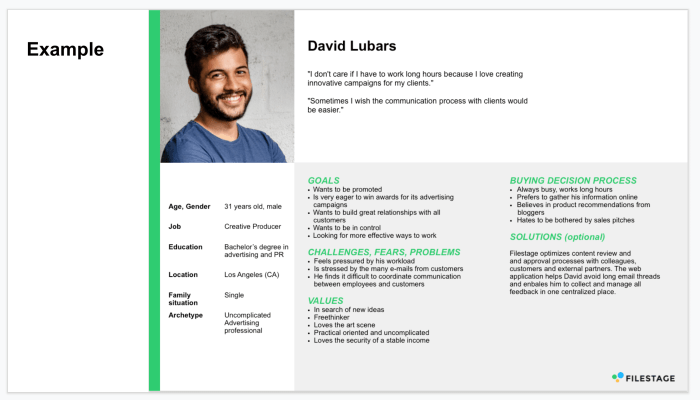Creating a Marketing Persona sets the stage for targeted marketing success, diving into the intricacies of understanding your audience on a deeper level. From demographics to psychographics, this process is a game-changer for businesses looking to make a lasting impact.
As we delve deeper into the realm of persona creation, the key components and strategies for building detailed profiles come to light, offering a roadmap for refining marketing efforts with precision.
Importance of Creating a Marketing Persona

Creating a marketing persona is crucial for businesses as it helps in understanding and targeting the right audience effectively. By creating detailed profiles of the ideal customers, businesses can tailor their marketing strategies to meet the specific needs and preferences of their target market.
Impact on Marketing Strategies
- Personalized Messaging: A well-defined marketing persona allows businesses to create personalized and targeted marketing messages that resonate with their audience.
- Improved Product Development: Understanding the needs and pain points of the target audience through personas can help in developing products/services that cater to their specific requirements.
- Enhanced Customer Engagement: By tailoring marketing efforts based on personas, businesses can engage with their audience more effectively, leading to higher conversion rates and customer loyalty.
Benefits of Tailoring Marketing Efforts
Tailoring marketing efforts based on personas can lead to higher ROI and improved marketing campaign performance.
- Cost-Effective Advertising: By focusing on the right audience through personas, businesses can optimize their advertising budget and achieve better results.
- Increased Customer Satisfaction: When marketing efforts are tailored to meet the needs of specific personas, customers feel understood and valued, leading to higher satisfaction levels.
- Competitive Advantage: Businesses that use marketing personas to tailor their strategies gain a competitive edge by delivering more relevant and personalized experiences to their target audience.
Research and Data Collection

When it comes to creating a marketing persona, conducting thorough research and collecting relevant data are crucial steps in developing accurate and effective personas. By gathering and analyzing data, marketers can better understand their target audience and tailor their marketing strategies to meet their needs and preferences.
Methods for Conducting Research, Creating a Marketing Persona
- Surveys and Questionnaires: Creating surveys or questionnaires can help gather valuable insights directly from the target audience.
- Interviews: Conducting in-depth interviews with current customers or potential leads can provide qualitative data for persona development.
- Analytics: Utilizing website analytics, social media insights, and other data sources can offer valuable information about audience behavior and preferences.
- Market Research: Studying industry trends, competitor analysis, and market reports can provide additional context for persona creation.
Data Points to Consider
- Demographic Information: Age, gender, location, income, education level, and other relevant demographic data.
- Psychographic Information: Interests, hobbies, values, attitudes, lifestyle choices, and personality traits.
- Behavioral Data: Purchasing behavior, online activity, content consumption habits, and brand interactions.
- Challenges and Pain Points: Identifying the problems, needs, and pain points that the target audience faces.
Importance of Analyzing Data
Analyzing data is essential for creating accurate personas because it allows marketers to identify patterns, trends, and insights that can inform persona development. By analyzing data effectively, marketers can ensure that their personas are based on real data and reflect the actual characteristics and behaviors of their target audience.
Identifying Demographics and Psychographics
When creating a marketing persona, it is crucial to identify both demographics and psychographics to have a comprehensive understanding of your target audience. Demographics focus on the tangible characteristics of your audience, such as age, gender, income, location, and education level. On the other hand, psychographics delve into the psychological aspects of your audience, including their values, attitudes, interests, and lifestyle choices.
Identifying Key Demographics
To identify key demographics for your personas, consider the following strategies:
- Conduct market research to gather data on your target audience’s age, gender, income level, and geographic location.
- Analyze your existing customer base to identify common demographic traits among your most loyal customers.
- Utilize social media insights and analytics tools to understand the demographics of your followers and website visitors.
- Survey your audience to gather direct feedback on their demographics and preferences.
Understanding Psychographics for Persona Development
Understanding psychographics can enhance persona development by providing deeper insights into your audience’s motivations and behavior. Here are some ways to leverage psychographics:
- Create customer surveys or interviews to uncover your audience’s values, interests, and lifestyle choices.
- Utilize social listening tools to monitor online conversations and identify trends in your audience’s beliefs and behaviors.
- Segment your audience based on psychographic variables to tailor your messaging and content to different audience segments.
- Develop empathy maps to visualize your audience’s thoughts, feelings, and motivations to inform persona development.
Creating Detailed Persona Profiles: Creating A Marketing Persona
Creating a detailed persona profile involves capturing a comprehensive picture of your target customer, including their demographics, psychographics, pain points, motivations, and behaviors. This information is crucial for tailoring your marketing strategies to effectively reach and engage with your audience.
Components of a Detailed Persona Profile
- Demographics: Include age, gender, location, income level, education, and occupation.
- Psychographics: Describe their interests, values, attitudes, and lifestyle choices.
- Behaviors: Detail their purchasing habits, online activities, and social media usage.
- Pain Points: Identify their challenges, frustrations, and obstacles they face in their daily lives.
- Motivations: Understand what drives them, their goals, aspirations, and what influences their decision-making process.
Template for Organizing Information Within a Persona Profile
| Section | Information |
|---|---|
| Demographics | [Insert detailed demographics information here] |
| Psychographics | [Describe psychographic details and lifestyle choices] |
| Behaviors | [Provide insights into purchasing habits and online activities] |
| Pain Points | [List out challenges, frustrations, and obstacles] |
| Motivations | [Explain what drives and influences their decisions] |
Significance of Including Pain Points and Motivations
- Understanding Pain Points: By identifying challenges and frustrations, you can tailor your products or services to address specific needs, enhancing customer satisfaction.
- Recognizing Motivations: Knowing what drives your target audience allows you to create compelling marketing messages that resonate with them, leading to increased engagement and loyalty.
- Personalizing Marketing Strategies: Incorporating pain points and motivations in persona profiles enables you to personalize your marketing efforts, making them more relevant and impactful.
Validating and Refining Personas
When it comes to marketing personas, it’s crucial to validate and refine them to ensure they accurately represent your target audience. This process involves gathering feedback and data to make necessary adjustments and improvements. By validating and refining personas, you can enhance the effectiveness of your marketing strategies and campaigns.
Importance of Validating Personas
Validating personas through feedback allows you to confirm if the characteristics and behaviors you’ve assigned to them align with real-world data. This feedback can come from customer surveys, interviews, or even observing customer interactions. By validating personas, you can ensure that your marketing efforts are targeted towards the right audience, leading to better engagement and conversions.
Methods for Refining Personas
- Conducting additional research: Keep gathering new data and insights to refine personas based on the latest information.
- Updating demographic and psychographic details: Adjust persona profiles as needed to reflect any changes in the market or audience preferences.
- Engaging with stakeholders: Collaborate with sales teams, customer service representatives, and other departments to gather feedback and refine personas effectively.
Iterative Process of Refining Personas
Refining personas is an ongoing process that requires constant monitoring and adjustments. By continuously refining personas based on new information, you can ensure that your marketing strategies remain relevant and resonant with your target audience.
